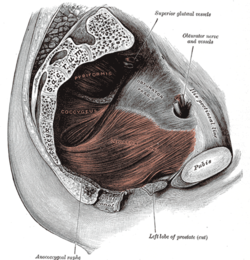Pubococcygeus muscle
| Pubococcygeus muscle | |
|---|---|

Muscles of the lower abdomen.
|
|
| Details | |
| Origin | back of the pubis and from the anterior part of the obturator fascia |
| Insertion | coccyx and sacrum |
| Nerve | S3, S4 |
| Actions | controls urine flow and contracts during orgasm |
| Identifiers | |
| Latin | musculus pubococcygeus |
| TA | A04.5.04.003 |
| FMA | 19090 |
|
Anatomical terms of muscle
[]
|
|
The pubococcygeus muscle or PC muscle is a hammock-like muscle, found in both sexes, that stretches from the pubic bone to the coccyx (tail bone) forming the floor of the pelvic cavity and supporting the pelvic organs. It is part of the levator ani muscle.
The pubococcygeus arises from the back of the pubis and from the anterior part of the obturator fascia, and is directed backward almost horizontally along the side of the anal canal toward the coccyx and sacrum, to which it finds attachment.
Between the termination of the vertebral column and the anus, the two pubococcygei muscles come together and form a thick, fibromuscular layer lying on the raphe (ridge) or (anococcygeal body) formed by the iliococcygei.
The greater part of this muscle is inserted into the coccyx and into the last one or two pieces of the sacrum.
This insertion into the vertebral column is, however, not accepted by all observers.
The pubococcygeus muscle controls urine flow and contracts during orgasm as well as assisting in male ejaculation. It also aids in childbirth as well as core stability.
A strong pubococcygeus muscle has also been linked to a reduction in urinary incontinence and proper positioning of the baby's head during childbirth.
The Kegel exercises are a series of voluntary contractions of all the perineal muscles. Such movement is done in an effort to strengthen all the striated muscles in the perineum's area. They are often referred to simply as "kegels", named after their founder, Dr. Arnold Kegel. These exercises also serve to contract, among others, the ischiocavernosus, bulbospongiosus, and cremaster muscle in men, as voluntary contraction of the pubococcygeus muscle also engages the cremasteric reflex, which lifts the testicles up, although this does not occur in all men. Kegel exercises have been prescribed to ameliorate erectile dysfunction due to venous leakage and to help men control premature ejaculation and to treat urinary incontinence in both sexes.
...
Wikipedia
